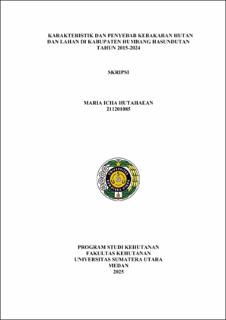Karakteristik dan Penyebab Kebakaran Hutan dan Lahan di Kabupaten Humbang Hasundutan Tahun 2015-2024

Date
2025Author
Hutahaean, Maria Icha
Advisor(s)
Thoha, Achmad Siddik
Metadata
Show full item recordAbstract
Forest and land fires are natural disasters that frequently occur in Indonesia with significant ecological and socio-economic impacts. Humbang Hasundutan Regency, as a leading ecotourism area in the Lake Toba region, has high vulnerability to forest and land fires due to geographical characteristics consisting of extensive forest areas and highland topography. BNPB data shows that North Sumatra has 1,069,467 hectares of critical land, most of which is located in the Lake Toba catchment area. This research aims to analyze the characteristics of forest and land fires in Humbang Hasundutan Regency based on time occurrence and location distribution for the period 2015-2024, as well as identify the main causes of fires. The research method uses hotspot data analysis from MODIS and VIIRS satellites with spatial analysis of anthropogenic and biophysical factors. The research results show that during the 2015-2024 period, 227 hotspot points were recorded with a confidence level above 50%. Temporal patterns show 2016 as the peak period with 30 hotspots in July, while monthly distribution indicates June-August as the critical period coinciding with the dry season. Spatial analysis shows that Other Land Use Areas (APL) have the highest hotspot density, followed by dryland agricultural areas and protected forests. The highest hotspot density occurs at distances of 1-3 km from roads and rivers, as well as within a 1-3 km radius from village centers, confirming the dominance of anthropogenic factors as fire triggers.
Collections
- Undergraduate Theses [2162]
